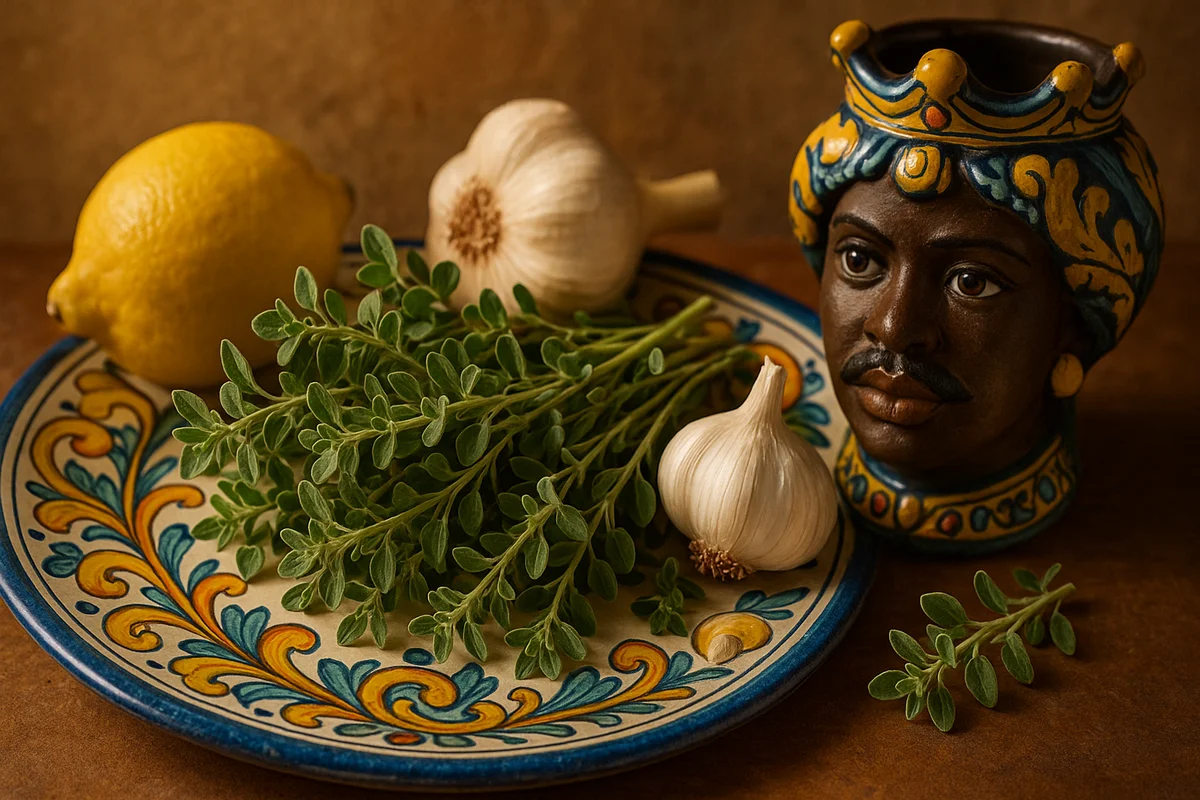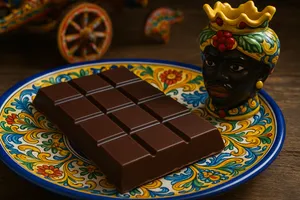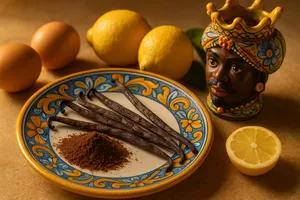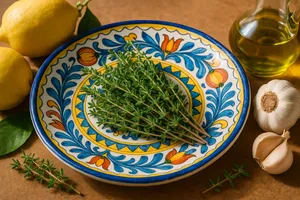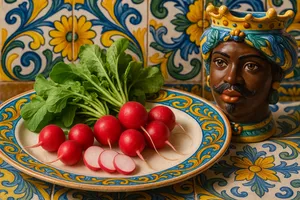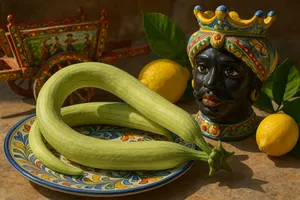Overview
Marjoram is a perennial aromatic herb belonging to the Lamiaceae family, closely related to oregano but with a gentler, more refined fragrance and flavour. Native to the eastern Mediterranean and perfectly adapted to the Sicilian climate, it has been used since antiquity both as a culinary herb and as a medicinal plant, appreciated for its sweet, slightly balsamic aroma.
In Sicilian cooking, marjoram holds a special place among aromatic herbs, particularly in dishes where a softer, more delicate touch is desired compared with oregano. Its velvety, fragrant leaves enrich roast meats, baked fish, stuffed vegetables, soups and many other preparations, imparting a characteristic aroma reminiscent of oregano but sweeter and less pungent. Every traditional Sicilian garden once hosted a few marjoram plants, used fresh during the warm months and dried for winter.
Characteristics
Marjoram is a herbaceous plant with small, oval, opposite leaves of greyish-green colour, covered with a fine down that gives them a velvety appearance. The leaves are smaller and more tender than those of oregano. The flowers are small, white or pale pink, gathered in compact inflorescences.
The fragrance is sweet, warm and slightly balsamic, with notes reminiscent of oregano but more delicate and less rustic, with almost floral nuances. The flavour is aromatic, gently sweet and peppery, less intense than oregano, with a faintly bitter finish and hints of pine and citrus.
Fresh marjoram has firm, bright green, highly aromatic leaves. When properly stored, dried marjoram retains its aroma well, with intact greyish-green leaves.
Cultivation
In Sicily, marjoram grows easily both in the ground and in pots. It prefers sunny positions and well-drained, light soil that is not too rich. It is a hardy plant that tolerates the Sicilian heat and, once established, withstands dry conditions, although regular watering helps produce more tender, fragrant leaves.
It can be propagated from seed in spring or by dividing established plants. It dislikes severe cold and excessive humidity. In mild Sicilian climates it can be grown as a perennial, although it tends to become woody over time and should be renewed every 2–3 years.
Leaves may be harvested throughout the growing season. For drying, flowering sprigs are gathered before full bloom, when the aroma is most intense, typically in mid-summer.
Use in cooking
In Sicilian cuisine, marjoram is used in a variety of preparations.
Roast meats
Marjoram flavours roast meats, particularly lamb, kid, rabbit and chicken. It is used fresh or dried, rubbed onto the meat before cooking or added during roasting.
Baked fish
Baked fish is often scented with fresh marjoram, which lends a delicate aroma without overwhelming the fish. It pairs especially well with sea bream, sea bass and other white fish.
Stuffed vegetables
Marjoram enriches the stuffing of vegetables such as aubergines, courgettes, peppers and tomatoes. It is mixed with minced meat, rice, cheese and other seasonings.
Soups and broths
It is added to legume soups, vegetable soups and broths to impart a gentle aroma. It is best added towards the end of cooking to preserve its fragrance.
Sauces and condiments
Marjoram flavours pasta sauces, meat ragùs and other condiments. It is used fresh or dried, often in combination with other herbs.
Omelettes and eggs
Finely chopped marjoram is mixed into eggs for delicately aromatic omelettes and scrambled eggs.
Flavoured oil
Sprigs of fresh marjoram are steeped in extra-virgin olive oil to create aromatic oils used to dress salads, vegetables and bruschette.
Preparation
Fresh marjoram should be used shortly before cooking to preserve its aroma. Rinse the sprigs gently under running water and pat dry. The leaves can be stripped from the stems and used whole or chopped, depending on the recipe.
For cooked dishes, marjoram may be added at the beginning of cooking for a soft, pervasive aroma, or towards the end for a more pronounced fragrance. Some recipes call for whole sprigs, which are removed before serving.
Dried marjoram has a more concentrated flavour: generally about one-third of the quantity used for fresh is sufficient. Rub the dried leaves between your fingers before adding them to dishes.
Drying
To dry marjoram, harvest flowering sprigs in the cool hours of the morning after the dew has evaporated. Tie them into small bunches and hang them upside down in a shaded, well-ventilated and dry place.
Drying takes 1–2 weeks. Once fully dried, remove the leaves and store them in airtight glass jars away from light and moisture. Properly dried marjoram maintains good aroma for 6–12 months.
Storage
Fresh marjoram keeps in the refrigerator for 3–4 days, wrapped in damp kitchen paper and placed in a perforated bag, or with the stems immersed in a glass of water like a small bouquet, loosely covered with a bag.
It can be frozen: washed, dried and chopped, then placed in ice-cube trays with water or oil. The cubes can be added directly to cooked dishes. Whole sprigs may also be frozen in bags.
Dried marjoram should be stored in airtight glass or metal jars in a cool, dry, dark place for 6–12 months. It gradually loses aroma, so it is best renewed each year with the new harvest.
Buying tips
When buying fresh marjoram, choose sprigs with bright green, firm, fragrant leaves. Avoid yellowing, wilted or darkened leaves, or any with spots indicating deterioration.
The leaves should be intact, free from signs of pests. The aroma should be strong and characteristic. Prefer locally grown marjoram, ideally organic and freshly harvested.
For dried marjoram, ensure the leaves are intact, greyish-green and free from dark patches. The aroma should still be present and pleasant. Check the packaging date: the more recent it is, the better the flavour.
Properties
Marjoram contains essential oils (mainly terpinene, terpineol and carvacrol), flavonoids, phenolic acids and tannins. It has digestive, carminative, antispasmodic and mildly sedative properties. Its essential oils have antimicrobial and antioxidant effects.
In Sicilian folk medicine, marjoram was used to prepare infusions considered helpful for digestion, to soothe coughs and as a gentle sedative. Fresh leaves were applied externally to ease muscular pain.
Marjoram tea was believed to alleviate headaches, insomnia and anxiety. It was prepared by pouring boiling water over fresh or dried leaves and steeping for ten minutes.
Difference from oregano
Marjoram and oregano are closely related and often confused, but they have distinct characteristics. Marjoram has smaller, softer, velvety leaves and a sweeter, more delicate fragrance with floral notes. Oregano has larger, tougher leaves and a stronger, more rustic and pungent aroma.
In cooking, oregano is preferred for rustic dishes requiring a pronounced flavour (pizza, focacce, tomato-based dishes), while marjoram is chosen for more delicate preparations where a subtler aroma is desired (white meats, fish, vegetables). They are only partially interchangeable, as each gives a different character to a dish.
Curiosities
In Greek mythology, marjoram was sacred to Aphrodite. It was used to make wedding garlands and believed to bring happiness to newlyweds. This association with love and joy earned it the nickname “herb of happiness” in some cultures.
In Sicilian tradition, marjoram was grown near homes not only for culinary use but also because it was believed to ward off evil spirits and bring peace and serenity to the household.
In the Middle Ages, marjoram was one of the most valued aromatic herbs in the gardens of Sicilian monasteries. Nuns cultivated it for medicinal and culinary purposes, preparing ointments, balms and infusions according to ancient recipes.
A traditional practice was to place dried marjoram sprigs in drawers and wardrobes to scent linen and repel moths. Its gentle fragrance lingered on fabrics for a long time.
Marjoram was also an ingredient in some homemade Sicilian digestif liqueurs, macerated with other aromatic herbs in alcohol. These liqueurs were offered to guests after meals as a digestive and a sign of hospitality.
In traditional herbal medicine, marjoram essential oil was considered precious. Diluted, it was used for massages to ease rheumatic and muscular pain, and in aromatherapy for its calming and relaxing properties.

